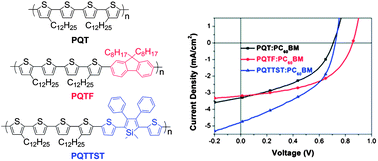Copolymerization of 3,3′′′-didodecylquaterthiophene with fluorene and silole units: improving photovoltaic performance by tuning energy levels
Abstract
We report the design, synthesis and characterization of two

* Corresponding authors
a
Department of Chemistry, Shanghai University, Shanghai 200444, P. R. China
E-mail:
wanghy@shu.edu.cn
b Key Laboratory of Molecular Engineering of Polymers(Fudan University), Ministry of Education, Shanghai 200433, P. R. China
c
Institute of Advanced Materials, Nanjing University of Posts and Telecommunications, Nanjing 210046, P. R. China
E-mail:
fliu0@polysci.umass.edu
d
Department of Polymer Science and Engineering, University of Massachusetts Amherst, Massachusetts 01003, USA
E-mail:
fliu0@polysci.umass.edu
We report the design, synthesis and characterization of two

 Please wait while we load your content...
Something went wrong. Try again?
Please wait while we load your content...
Something went wrong. Try again?
H. Wang, J. Gao, W. Tong, Q. Qian, K. Lin and F. Liu, Polym. Chem., 2012, 3, 2794 DOI: 10.1039/C2PY20460F
To request permission to reproduce material from this article, please go to the Copyright Clearance Center request page.
If you are an author contributing to an RSC publication, you do not need to request permission provided correct acknowledgement is given.
If you are the author of this article, you do not need to request permission to reproduce figures and diagrams provided correct acknowledgement is given. If you want to reproduce the whole article in a third-party publication (excluding your thesis/dissertation for which permission is not required) please go to the Copyright Clearance Center request page.
Read more about how to correctly acknowledge RSC content.
 Fetching data from CrossRef.
Fetching data from CrossRef.
This may take some time to load.
Loading related content
